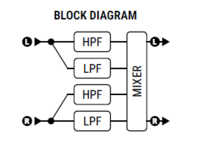This is the wiki for products made by Fractal Audio Systems, maintained by members of the community.
Difference between revisions of "Crossover block"
Jump to navigation
Jump to search
| Line 4: | Line 4: | ||
* '''Axe-Fx III''': 2 blocks | * '''Axe-Fx III''': 2 blocks | ||
| − | * '''FM3''': | + | * '''FM3''': no |
* '''Axe-Fx II''': 2 blocks | * '''Axe-Fx II''': 2 blocks | ||
* '''FX8''': no | * '''FX8''': no | ||
Revision as of 22:40, 16 January 2020
Contents
Available on which products
- Axe-Fx III: 2 blocks
- FM3: no
- Axe-Fx II: 2 blocks
- FX8: no
- AX8: no
Channels or X/Y switching
- Axe-Fx III: 2 channels
- Axe-Fx II: no
What is a crossover
The Crossover block is a simulation of an electronic crossover. A crossover splits the audio signal into frequency ranges, to be processed or amplified separately.
More explanation:
Parameters table
| Parameter | Axe-Fx III | Axe-Fx II |
|---|---|---|
| Lo/Hi Level Left/Right | yes | yes |
| Lo/Hi Pan Left/Right | yes | yes |
| Frequency | yes | yes |
| Frequency Multiplier | yes | yes |
Tips and tricks
Bi-amping
Some bass/guitar players split their signal in highs and lows, and send them through different amplifiers. This can be accomplished with the Crossover block. The factory preset "Plexi Bi-Amp" demonstrates this. Or check Leon Todd’s tutorial.
